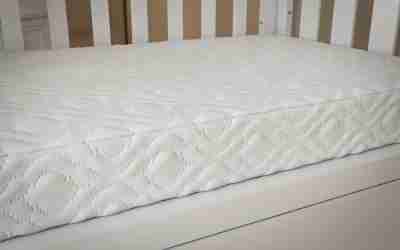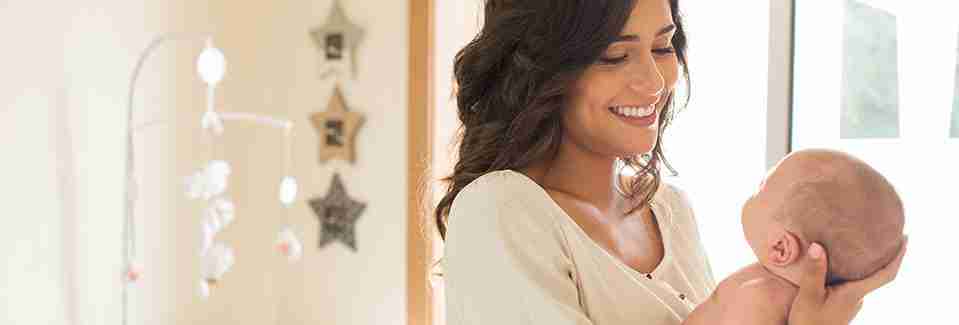It is important to choose the right cot mattress for your little one. This guide will help you prepare the best and safest sleeping space for your baby.
Need to Knows – Safety of cot mattresses
- Make sure you choose the right sized mattress for your cot. The mattress must fit the cot without any gaps that are more than 3cm.
- Make sure the mattress is firm with good support, not soft to avoid a potential risk of suffocation.*
- Always check that the mattress doesn’t sag and lies flat with no tears, cracks or holes.
- Always keep baby’s mattress clean and dry and use with a waterproof cover.
- Check that the mattress conforms BS EN 16890:2017 safety standards.
- The Lullaby Trust recommends that you should buy a new cot mattress for each new baby. Avoid used cot mattress where possible.
Your cot will specify the size of the mattress that fits it. A UK standard Cot requires a mattress size of 120 x 60 cm.
A UK standard Cot Bed requires a mattress size of 140 x 70 cm.
If you have a non-UK standard cot, you will have to order customize made mattress to fit it.
Cot mattress thicknesses are specified in BS EN 16890:2017, the safety regulation that governs cot mattresses. We recommend a cot mattress of 10 cm thickness which should provide adequate support to your baby’s needs, and hold its shape better. Avoid 7-8 cm cot mattresses unless it’s only for occasional use. To stop babies climbing out of cots, the British standard currently states that no mattress should be over 10 cm in depth,
Hypoallergenic – means the mattress cover can be washed at 60°C to kill any dust mites that may cause allergies. Each of our Babymore mattresses come with a hypoallergenic cover which are zipped for easy removal.
TYPE OF MATTRESS
Foam mattress: Traditional, most common used – Foam, it provide good support. Look for a high density foam that resists dents. They are easy to clean and are good value for money. Avoid mattresses with ventilation holes as they can be difficult to wash.
Fibre mattress: it will gradually replace foam for nursery mattress, for obvious advantages, chemical free, also good support, recyclable, washable and breathable. No foam discoloration No odor.
Spring or Sprung mattress: The traditional bonnel spring /open coils mattresses offer excellent support and improved air circulation. The cover is double-sided with layered felt and foam padding. The stocking netted core enables easy cover removal.
These are generally more expensive than foam mattresses.
Pocket Spring mattress: These have individual pocketed springs to provide more support and comfort than traditional bonnel spring unit. They usually come with a full bonded edge cover.
They are usually more expensive than a bonnel spring mattress.
Coir fibre mattress: A Coconut/coir fibre core mattress is the firmest type of mattress. The core helps air circulation and is often the most expensive to buy. They are the most durable, but unfortunately the firmness is not liked by every child.
*Memory foam is not recommended for baby mattresses, it’s made with additional chemicals and the unique “viscoelastic” property moulds to body heat. This is not ideal for a baby to sleep in, as it carries a suffocation risk to young infants.
CARING FOR YOUR BABY’S MATTRESS
Regularly cleaning your baby’s mattress is vital to ensure that they enjoy a hygienic sleep, it also means that the mattress will last longer.
- Regularly Vacuum or sponge clean the sleeping surface.
- Regularly Wash mattress cover at 60°C with non-biological mild detergent.
- Turn regularly to maintain shape or rotate head to foot for equally used ends.
- Do not use a mattress that has not fully dried
- Do not dry clean or use chemical detergent that could be harmful to your baby
- Do not expose mattress for an extended period without a sheet or cover, to prevent the oxidation of foam and UV discoloration. *
*Foam in nursery mattresses undergoes a yellow discoloration when exposed to light and air for extended periods. This is a surface oxidation effect caused by UV light or nitrous oxides in the air. The exposed areas discolour whereas the protected areas by bed slats/surface covering do not. For Adult mattress, additional chemical may be added to prevent such discoloration, but this is not allowed for nursery mattress. UV discoloration is permanent and is a natural occurrence that affects exposed surfaces; it does not affect the physical properties and is safe to use. The best way to prevent foam from discolouration is to use a mattress cover.
Keep direct sunlight away from the mattress. Do not allow the mattress to sit for extended periods without sheets and blankets. Cover the mattress well if not use for a long period or is in storage.













